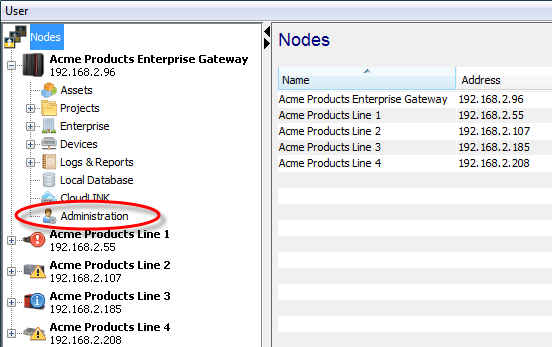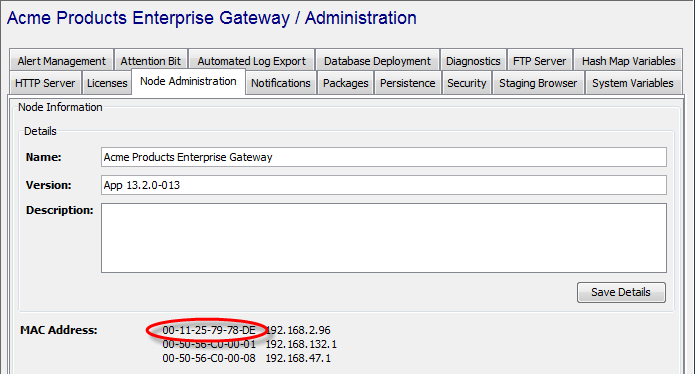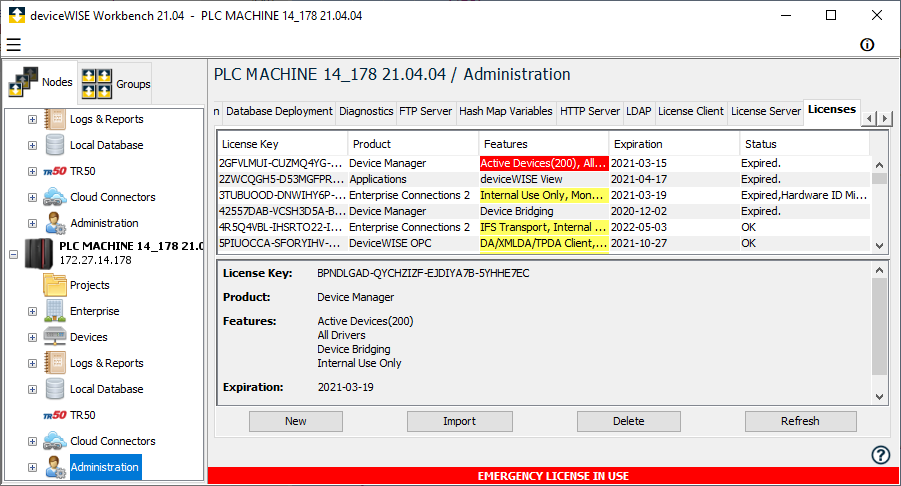The Licenses tab is used to view the
current licenses and to add licenses to the node. Some licenses are automatically added to the node
when the node connects to the deviceWISE Cloud.
In order to use a feature of node, the node must have a license for that feature. Some features of a node are available without the need to install a license. Some licenses must be installed in a node using the Licenses tab. Licenses can be imported from a file or entered one at a time via the keyboard.
Each license allows access to its specific feature, such as:
- Execution of triggers
- Use of transports and listeners to access database servers and messaging server enterprise applications (IBM DB2, Oracle, Microsoft SQL Server, MySQL, WebSphere MQ, and so forth.)
- Device drivers, and more.
License keys are specific to a node. They are not required to enable features in the Workbench, but rather to enable features in the node connected to by the Workbench.
Once you have installed licenses on a node, any changes to the node and the hardware identifier used to generate the licenses may cause the licenses to become invalid. For example, if a MAC address is used for a node to generate licenses and the MAC address is changed by substituting a different network interface card, then the licenses will become invalid.
To an optimized experience, System Serial Number should be the preferred ID to generate licenses. Through the usage of SSN instead of Mac Address, issues with Hardware ID Mismatches due to IP changes might be avoided.
In the "License Server" tab, the "Outstanding Licenses" table only shows pooled licenses because, for non-pooled ones, one key serves all gateways.
Therefore, in the "Licenses" tab of the License Server, all the keys that refer to the same product and don't have a counter associated are duplicates and can be removed, leaving just one.
If a license shows as "Unknown", update your Workbench to the latest version.
Terminology used in this section
| Term | Description |
|---|---|
| License key | A character text string that
represents a license. A license key
will be similar to the following: GJDR25DV-6FJFCKXC-FRSUVXA3-QUJBIUAY |
| License file | A text file that contains one or more license keys. |
| Emergency License | A temporary "emergency" license
generated when a valid license key for
the node becomes invalid, such as a
hardware ID mismatch. For more information, see Emergency licenses. |
License file
When you purchased your software, you may have also received a license file to import into the node. Continue with the section, Importing the license file. If you did not receive a license file or need to generate license keys, continue with the next section, Obtaining the hardware identifier of the node.
In order to generate a license keys, you must first obtain the unique serial number or hardware identifier of the node. This hardware identifier may be a:
- MAC Address
- Serial number
- Other unique hardware identifier
For some hardware types, the MAC address or serial number may be listed on a label on the outside of the hardware.
For the Siemens CP 343-1 ERPC module, the serial number is listed as the SVP number displayed under the front cover and on the side (under the part number) of the CP 343-1 ERPC module.
The possible hardware identifiers for a node are
available from the Workbench, Node
Administration tab, as described in the following
steps:
It is assumed that you have started the Workbench and
successfully logged on
- From the left pane, expand the node for which you want to obtain the hardware identifier
- Click Administration.

The Administration screen appears - Select the Node Administration
tab.
- Next to the label MAC Address (for
many node types), Serial Number (for
MESInterface IT) or SVP Number (for
Siemens ERPC), record one of the strings that
appear.
Some node types display several hardware identifier strings, for example: a MAC address, a serial number, an IMEI, and an ICCID. Only one of the hardware identifier strings is needed for the license generation step.
You can select and then copy the characters using Ctrl-C. Later you can paste the characters using Ctrl-V.
Now that you have the hardware identifier, you will be able to generate license keys.
If you are using the deviceWISE Cloud and your organization is configured to access the Gateway licenses feature, you can generate license keys using the Management Portal.
For more information, see Gateway Licenses.
Otherwise, contact Technical Support for information on requesting and receiving license keys.
An Asset Gateway or Enterprise Gateway can automatically download licenses when it connects to the deviceWISE Cloud. This automatic downloading of licenses only takes place if the node does not currently have any licenses. For example: When the node connects over TR50 to the deviceWISE Cloud for the first time. For more information, see: Access Tokens.
You can use the Licenses tab to import a license file into the node. Follow these steps:
- At the bottom of the Workbench Administration ->
Licenses tab, select
Import.
The License File Location window appears. - Change to the location of the downloaded license
file on the computer running the Workbench.
- Select the license file you want to import, and
then select Open.
A message will list the license keys to be imported.
Select Yes. - A message will tell you that the licenses were
successfully added.
Select OK. - Select Refresh.
The license information is added to the Licenses tab.
You can use the Licenses tab to add a single a license key into the node. Follow these steps:
- At the bottom of the Workbench Administration ->
Licenses tab, select
New.

The New License window appears. - In the License Key box, enter the
license key, and then select OK.
You can also copy (Ctrl-C) the license key from its source and then paste (Ctrl-V) the license key into the License Key field. - A message appears indicating the new license was
added to the node.
Click OK. - Click Refresh.
The license information is added to the Licenses tab.
After you have completed adding license keys to a node, the Gateway Developer's Guide and Reference sections have information on application development, configuration, and the features enabled by the licenses just added.
License keys is exported to a file by selecting the license key(s), right-clicking and selecting the Save to File option.
Part of a node's start up processing is to check the licenses that have been added to the node to see if they are valid for the node. If they are no longer valid for the node, temporary emergency licenses are created. The temporary emergency licenses allow the node to access the features that it is entitled to based on the licenses that are no longer valid.
The existence of emergency licenses is indicated by the
red ribbon at the bottom of the Workbench when any of the
node's windows are displayed. The details of the licenses
for the node are shown on the Administration ->
License tab. For example:
Emergency license considerations
- Licenses generated for a node using a specific hardware ID are only valid for that node, they cannot be used on a node with a different hardware ID.
- Licenses may or may not have an expiration date, but the expiration of a license does not create an emergency license.
- Evaluation licenses may be able to be generated without entering a hardware ID.
- If you misplace a license that you previously generated from the Management Portal, you can download a copy of the license information and import it into a node.
- If a node has a hardware problem and the hardware
ID changes, for example a network interface card fails
and a replacement card has a different MAC Address, a
new license must be generated to match the new MAC
address.
In the interim time frame, emergency licenses should have been created to allow the node to continue to use the features it is entitled to use. - Emergency license have an expiration date as indicated on the Licenses tab in the Expiration column. The emergency licenses have the term "Emergency" in the Features description and have a red background.
- The license(s) that caused the emergency license to be created will indicate Hardware ID Mismatch in the Status column.
- Beginning with release 16.1.9, the generation of an emergency license takes into account the presence of a valid license for a feature set. If there is a valid license for a feature set, then an invalid license for the same feature set will no longer cause an emergency license to be generated. Some configurations may include a set of licenses for multiple hardware IDs. For example: one set of licenses for MAC address "A" and a second set of licenses for MAC address "B", where only one of the MAC addresses would be valid depending on the system's current operating environment (cluster and High Availability environments).
- License keys can be exported to a file by selecting the license key(s), right-clicking and selecting the Save to File option.
- License keys can be deleted by selecting the license key(s) and then selecting the Delete button.
- Contact Technical Support for any questions related to emergency licenses.
There are license.XXX System Variables that can be monitored by a trigger for notification purposes. The System Variable Get trigger action can be used to retrieve specific system variable values and then, for example, forwarded to the appropriate personnel using the E-mail action.
Licenses for four concurrent sessions are available with the base runtime installation. Licenses for concurrent sessions beyond the provided four licenses must be acquired through a HTTP API Server license. If there are any question regarding the availability of licenses, contact your support representative.
Each user session to the HTTP Server acquires a license. The license remains in use as long as the session remains active. When the session ends, the license is no longer in use and is available for another user session.
A license key for the Device Manager Product contains the number of active devices that are supported on the node. If there multiple Device Manager license keys, then the number of active devices from all Device Manager keys are summed together for the total number supported on the node. For licensing purposes, an Active Device includes:
- A device that is in the Started
state.
- Aliases devices, Global Variables devices, and Property devices in the Started state are not included in the active device license usage counts. The Sysmon device is not included in the active device license usage counts. Local I/O drivers associated with hardware on specific gateways (e.g. Advantech Uno, Artila PAC5070, B&B Spectre, CalAmp, Gatetel, Moxa, Multitech, Netcomm, Systech Syslink) do not count toward the active device license usage counts.
- A current connection initiated from a client to a
Started server or listener type device. The server or
listener type devices that require an active device
license for a connection includes:
- Modbus Server device
- TCP Listener device
- Rockwell Listener device
- Siemens Listener device
- Mistubishi Listener device
- Omron CIP Listener device
- Omron device
There are device.XXX System Variables that display count information related to started devices and active device license usage.
A system generated Alert will be displayed when the
number of active device licenses in use exceeds a threshold
percentage of the total active device licenses for the
node. The Alert is cleared when the usage drops below the
threshold percentage. For example:
The default is 90%. This default value can be modified by
including a properties file entry. For example:
- device.license.threshold=75
For information on adding properties, see Properties file management.
Active devices license example
An example of the active device license concepts, across the Licenses tab, System Variables tab and the Devices panel:
- A node has a Device Manager license key that
indicates 25 active devices. This is seen in the
Licenses tab.
The device.license.total value shown on the System Variables tab is 25. - The Devices panel is used to define 30 devices
across the device drivers that are supported on the
node. The 30 devices are all in the Stopped
state.
The device.count value shown on the System Variables tab is now 30. - 5 of the 30 defined devices are started, and change
to the Started state.
The device.started.count value shown on the System Variables tab is now 5.
The device.license.in_use value shown on the System Variables tab is now 5.
Aliases devices, Global Variables devices, and Property devices in the Started state are not included in the active device license usage counts. - A Modbus Server device was one of 5 devices that
was started.
- A Modbus client connects to the Modbus Server
device. To accept the client connection, the Modbus
Server requires an available active device
license.
The device.started.count value shown on the System Variables tab is still 5.
The device.license.in_use value shown on the System Variables tab is now 6. - If 24 additional Modbus clients connect to the
Modbus Server device, they would each reserve an
active device license.
The device.started.count value shown on the System Variables tab is still 5.
The device.license.in_use value shown on the System Variables tab is now 30 (6 plus 24). - If one additional Modbus client attempted to
connect to the Modbus Server device, it's connection
would not be accepted since there is no active device
license available.
The device.license.rejected value shown on the System Variables tab is incremented (originally 0, its now 1). The device.license.rejected value is reset to 0 when the node is re-started. - If one of the originally defined devices from
bullet 2 above is attempted to be started, it would not
succeed since there is no active device license
available.
- When a Modbus client ends its connection to the
Modbus Server, the active license it was using is
returned and available for use.
The device.license.in_use value shown on the System Variables tab is decremented by 1. - When any of the Started devices are stopped, the
active license it was using is returned and available
for use.
The device.started.count value shown on the System Variables tab is decremented by 1.
The device.license.in_use value shown on the System Variables tab is decremented by 1. - If the Modbus Server device was stopped, then all
of the client connections would be ended and all of the
active device licenses it was using would be returned.
The device.license.in_use value would be decremented
for each returned active device license.
- In addition to the node-wide System Variables tab
device.XXX values, the device information on the
Devices panel for a started device (in this example the
Modbus Server device) displays counts on its Attributes
sub-tab:
- License In-Use
- License Rejected.
With Listener devices, the number of devices starting are counted, plus the thing that connects to the listener. Each thing that connects to a listener uses a license. So If a person have an active TCP LIstener that connects to 4 things, 5 licenses are being used, seeing that the Listener needs to be taken into account.
The same applies if it's a passive TCP Listener. The Passive TCP Listener opens a port and listens, that counts as one connection. If three things connect to the listener it will consume 4 licenses. Those licenses are used as long as those things are connected to the listener.
To ensure that you receive Telit Support services and future updates of deviceWISE software, a Technical Support License (TSL) must be installed. Beginning with the deviceWISE v22.01 release, customers will see messages in the Workbench if a TSL is missing, expired, or approaching expiration. Please see this page for more information: